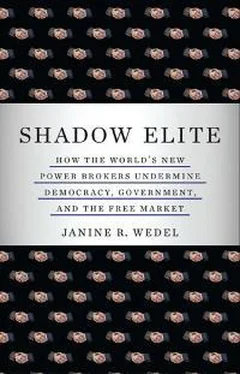The number of NSA-approved contractor facilities was reported by Shaun Waterman, “Unveiling US Intel Spending and Contractors,” Washington (UPI), June 27, 2007, http://www.spacewar.com/reports/Unveiling_US_Intel_Spending_And_Contractors_999.html. The data on the National Reconnaissance Office are from Tim Shorrock. See his “Private Spies,” New York Post , May 11, 2008, http://www.nypost.com/seven/05112008/postopinion/postopbooks/private_spies_110301.htm.
In another example of intelligence outsourcing, in August 2007 the Defense Intelligence Agency (DIA) announced its plans to contract out upwards of $1 billion to private companies. These contractors would conduct, in the words of the DIA (as published on a procurement Web site) “operational and mission requirements” that involve “Gathering and Collection, Analysis, Utilization, and Strategy and Support” of intelligence—in other words, some core intelligence functions. Walter Pincus, “Defense Agency Proposes Outsourcing More Spying: Contracts Worth $1 Billion Would Set Record,” Washington Post , August 19, 2007, p. A3, http://www.washingtonpost.com/wp-dyn/content/article/2007/08/18/AR2007081800992.html.
32. The GAO information cited is from Testimony of John P. Hutton, Acting Director, Acquisition and Sourcing Management, Government Accountability Office, “Defense Acquisitions: Improved Management and Oversight Needed to Better Control DOD’s Acquisition of Services,” May 10, 2007, pp. 2, 5, http://www.gao.gov/cgi-bin/getrpt?GAO-07-832T.
The 2007 figures, compiled from State and Defense Department sources, were reported in: T. Christian Miller, “Private Contractors Outnumber U.S. Troops in Iraq,” Los Angeles Times , July 4, 2007, http://www.latimes.com/news/nationworld/nation/la-na-private4jul04,1,7664713,full.story?coll=la-headlines-nation. The article states that these figures may underrepresent private security contractors. The 2008 numbers are from Congressional Budget Office, “Contractors’ Support of U.S. Operations in Iraq,” August 2008, p. 9, http://www.cbo.gov/ftpdocs/96xx/doc9688/08–12-IraqContractors.pdf. The 1991 figures can be found in John M. Broder and James Risen, “Contractor Deaths in Iraq Soar to Record,” New York Times , May 19, 2007, http:///www.nytimes.com/2007/05/19/world/middleeast//19contractors.html.
33. The Acquisition Advisory Panel report is Acquisition Advisory Panel, Report of the Acquisition Advisory Panel to the Office of Federal Procurement Policy and the United States Congress , January 2007, pp. 391–392, 417, http://acquisition.gov/comp/aap/24102_GSA.pdf.
With regard to insourcing, see, for instance, Elise Castelli, “The Case for Insourcing,” Federal-Times.com, September 21, 2008, http://www.federaltimes.com/index.php?S=3733576. The article also states that insourcing, which has been done on a limited basis in the Navy, the Army, the Internal Revenue Service, and the Department of Homeland Security, is “rare.”
34. Schinasi is cited in Daniel Zwerdling, “Obama To Tackle Explosion In Federal Contracts,” National Public Radio, December 1, 2008, http://www.npr.org/templates/story/story.php?storyId=97322339.
The army’s guess is reported in Guttman, “The Shadow Pentagon.”
35. For Defense’s difficulty in monitoring contractors, see GAO, High Risk Series: An Update , Washington, DC: GAO, GAO-07–310, January 2007, p. 67, available at http://www.gao.gov/new.items/d07310.pdf. GAO’s report on industrial security is GAO, Industrial Security: DOD Cannot Ensure Its Oversight of Contractors under Foreign Influence Is Sufficient , GAO-05-681, Washington, DC, July 2005, pp. 3, 5, http://www.gao.gov/new.items/d05681.pdf. For GAO’s new high-risk category: GAO, High Risk Series: An Update , Washington, DC: GAO, GAO-07–310, January 2007, pp. 25, 6, available at http://www.gao.gov/new.items/d07310.pdf.
36. Press Release, Booz Allen’s Extensive Ties to Government Raise More Questions About SWIFT Surveillance Program , ACLU, September 26, 2006, http://www.aclu.org/safefree/spying/26808prs20060926.html. For further information about this case, see Josh Meyer and Greg Miller, “U.S. Secretly Tracks Global Bank Data,” Los Angeles Times , June 23, 2006, p. A1, http://articles.latimes.com/2006/jun/23/nation/na-swift23; Eric Lichtblau and James Risen, “Bank Data Is Sifted by U.S. in Secret to Block Terror,” New York Times , June 23, 2006, p. A1, http://www.nytimes.com/2006/06/23/washington/23intel.html; and Eric Lichtblau, “Europe Panel Faults Sifting of Bank Data,” New York Times , September 26, 2006, p. A1, http://www.nytimes.com/2006/09/26/us/26swift.html.
37. To name just one instance, Katherine Schinasi, a top official at the GAO, described a high-level meeting she attended at a military command. Because she did not know any of the participants, she asked everyone around the table who employed them. “There were several people who worked for the military command, but the majority of people sitting at the table worked for contractors,” she said. Interviewed by Zwerdling, “Obama to Tackle Explosion in Federal Contracts.”
38. GAO-08–142T, Government Accountability Office, Testimony Before the Committee on Homeland Security and Governmental Affairs, United States Senate, Department of Homeland Security: Risk Assessment and Enhanced Oversight Needed to Manage Reliance on Contractors, Statement of John P. Hutton, Director Acquisition and Sourcing Management, Wednesday, October 17, 2007, Executive Summary, http://www.gao.gov/new.items/d08142t.pdf.
39. For details about the biosurveillance shop SAIC suggested, see Robert O’Harrow Jr., “Biosurveillance, Intelligence and Bugs,” Government Inc., Blog, August 13, 2007, http://voices.washingtonpost.com/government-inc/2007/08/biosurveillance_intelligence_a_1.html. For details about SAIC writing the rules, see Robert O’Harrow Jr., “As the government hires more contractors, some have helped draft rules that could benefit their businesses. A federal jury cited SAIC in one such case. SAIC sees no conflict.” Washington Post , August 18, 2008, p. D, D3.
40. The three-quarters estimate was made by the market research firm INPUT in Chantilly, Virginia, and reported in Government Executive (“Experiences Give and Take,” Government Executive , July 1, 2003, www.govexec.com/feature/0603/ots03s4.htm). The Acquisition Advisory Panel similarly assesses that “Most, if not all, agencies have contracted out major portions of their information technology and communications functions” (Acquisition Advisory Panel, Report of the Acquisition Advisory Panel to the Office of Federal Procurement Policy and the United States Congress , January 2007, p. 399, http://acquisition.gov/comp/aap/24102_GSA.pdf). A notable exception to governmental dependence on privately executed IT is government’s underwriting of technological advancement, which often is achieved in government laboratories. However, even in this case, government often lacks in-house expertise and capacity and has little choice but to turn to the private sector. Burlin is cited in Government Executive , “Experiences Give and Take.”
The Guttman quote is from Guttman, “The Shadow Pentagon.”
41. Figures on employees in Homeland Security are from GAO, “DHS’s Actions to Recruit and Retain Staff and Comply with the Vacancies Reform Act,” July 2007, pp. 15–16, at http://www.gao.gov/new.items/d07758.pdf.
Information about the demoralized FEMA professionals is from the nonprofit Partnership for Public Service, whose mission involves the promotion of federal government careers. The professionals were displaced by or did not want to work for the inexperienced political appointees installed under the Bush II administration. The Partnership for Public Service ranked FEMA last among the 28 agencies it studied in 2003. The American Federation of Government Employees, which surveys employees and lists the best places to work in government, found in 2004 that of 84 career FEMA professionals who responded, only 10 of them ranked their agency leaders as excellent or good. Another 28 employees called their leadership fair, while 33 said it was poor. More than 50 employees responded that they would go to another agency if they could stay at the same pay level, while 67 said the agency had become poorer since it merged into the Department of Homeland Security. Spencer S. Hsu, “Leaders Lacking Disaster Experience: ‘Brain Drain’ At Agency Cited,” Washington Post , September 9, 2005, p. A1, http://www.washingtonpost.com/wp-dyn/content/article/2005/09/08/AR2005090802165.html.
Читать дальше












